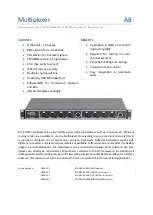
46
Handshake Lines: The transfer of message bytes between devices is done via
three asynchronously control lines. Referred to as three-wire interlocked
handshake. This guarantees that message bytes on the data lines are sent and
received without transmission error.
NRFD
(not ready for data) indicates when a device is ready or not ready to
receive a message byte.
NDAC
(not data accepted) indicates when a device has or has not accepted a
message byte.
DAV
(data valid) tells when the signals on the data lines are stable (valid) and
can be accepted safely by devices.
Interface Management Lines: Five lines are used to manage the flow of
information across the interface.
ATN
(attention) ATN is driven true by the controller when it uses the data lines to
send commands, and drivers ATN false when a Talker can send data messages.
IFC
(interface clear) IFC is driven by the system controller to initialize the bus
and become CIC.
REN
(remote enable) The REN line is driven by the controller which is used to
place devices in remote or local program mode.
SRQ
(service request) The SRQ line can be driven by any device to
asynchronously request service from the Controller.
EOI
(end or identify) This line has two purposes- the Talker uses this line to
mark the end of a message string, and the Controller uses it to tell devices to
identify their response in a parallel poll.
GPIB Connector
Connection is usually accomplished with a 24-conductor cable with a plug on one
end and a connector at the other end. Devices may be connected in a linear,
star or a combination configuration.
The standard connector is the Amphenol or Cinch Series 57 Microribbon or AMP
CHAMP type. The GPIB uses negative logic with standard transistor-transistor
logic (TTL) levels. When DAV is true, for example, it is a TTL low level (
0.8 V),
and when DAV is false, it is a TTL high level (
2.0 V).
Restrictions and Limitations on the GPIB
















































